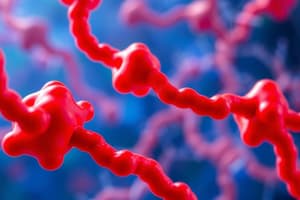Podcast
Questions and Answers
What are the general principles of G-protein-coupled receptor (GPCR) signaling mechanisms?
What are the general principles of G-protein-coupled receptor (GPCR) signaling mechanisms?
GPCRs involve G protein binding, second messenger binding, and kinase-mediated phosphorylation.
What type of channels produce fast and localized responses?
What type of channels produce fast and localized responses?
- Intracellular receptors
- G-protein coupled receptors
- Ligand gated channels (correct)
- Tyrosine-kinase-linked receptors
G-protein coupled receptors produce responses that are fast, small, and localized.
G-protein coupled receptors produce responses that are fast, small, and localized.
False (B)
Which of the following is a mechanism of G-protein coupled receptor signaling?
Which of the following is a mechanism of G-protein coupled receptor signaling?
What happens when GTP is hydrolyzed into GDP?
What happens when GTP is hydrolyzed into GDP?
Match the G-proteins with their functions:
Match the G-proteins with their functions:
How many different genes for GPCRs are there?
How many different genes for GPCRs are there?
Responses to the same neurotransmitter depend on the type of receptor activated.
Responses to the same neurotransmitter depend on the type of receptor activated.
What type of currents does mAChR regulate?
What type of currents does mAChR regulate?
Flashcards are hidden until you start studying
Study Notes
G-Protein Coupled Receptors (GPCRs) Overview
- GPCRs are a superfamily with over 1000 different genes, responding to various small molecules and neuropeptide hormones.
- Classified by function into Gs (stimulates adenylyl cyclase), Gi (inhibits adenylyl cyclase), Gt (activates phosphodiesterase in retina), Go (regulates ion channels), and Gq (couples to phospholipase).
Signaling Mechanism
- Activated GPCRs stimulate G proteins, causing them to bind GTP and dissociate into active subunits.
- G proteins consist of three subunits: α (alpha), β (beta), and γ (gamma).
- The α subunit binds GTP, regulating downstream signaling cascades before returning to a resting state by hydrolyzing GTP to GDP.
Responses and Effects
- GPCR responses are typically slower, smaller, longer-lasting, and more widespread compared to ligand-gated ion channels.
- Different ion channels activated by GPCRs determine specific cellular responses.
- For example, activation of mAChR (muscarinic acetylcholine receptor) affects ion channel currents differently than nAChR (nicotinic acetylcholine receptor).
Types of Receptors
- Cell surface receptors include directly-gated ion channels (ligand-gated) and GPCRs.
- Other receptors involve tyrosine-kinase-linked and enzymatic activity-linked receptors, as well as intracellular receptors like steroid hormones.
GPCR Diversity
- GPCRs exhibit extensive diversity due to multiple isoforms for each subunit, generating numerous combinatorial possibilities in signaling.
- The same neurotransmitter can elicit different reactions depending on the GPCR type activated, highlighting the specificity of responses.
Ion Channel Regulation Examples
- Responses to acetylcholine include modulation of potassium channels (K) and calcium channels (Ca), revealing different physiological outcomes based on receptor activation.
- GPCR-mediated effects on ion channels can either excite or inhibit cellular activity depending on the receptor subtype.
Key Takeaways
- GPCRs play a pivotal role in cell-cell communication and signal transduction.
- Understanding GPCR mechanisms and diversity is critical for pharmacology and the development of selective drugs.
Studying That Suits You
Use AI to generate personalized quizzes and flashcards to suit your learning preferences.




